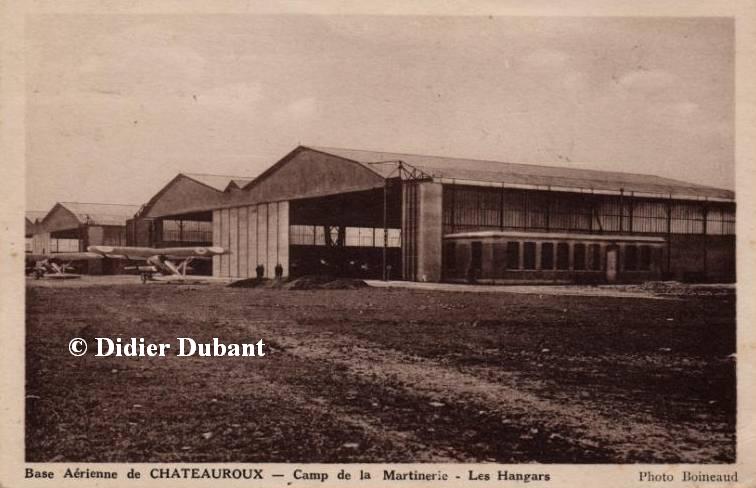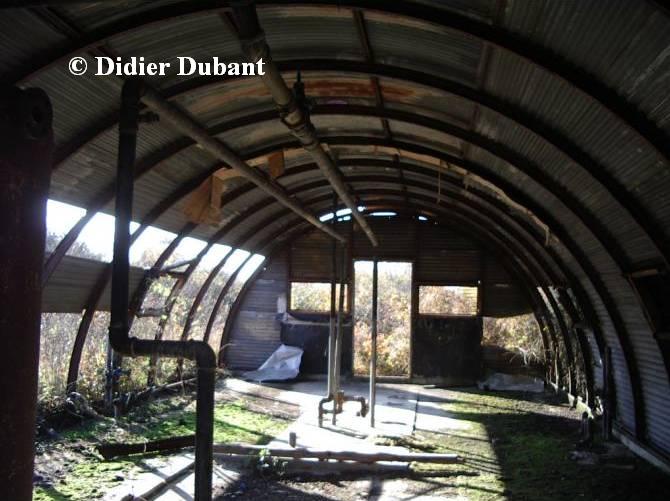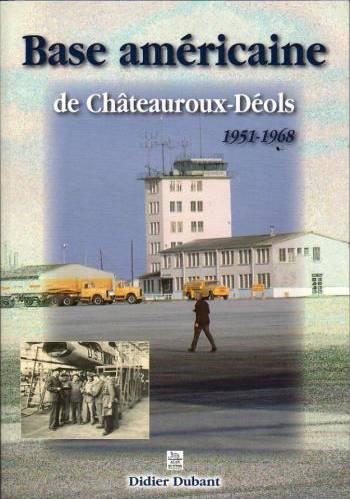(Didier Dubant collection)
| Be careful if Guynemer stayed in Avord, he never came to La Martinerie These names are simply a tribute to the heroic fighter pilot that he was |
| Study and presentation by Didier Dubant |
|
The Martinerie military base was created on October, 25, 1915. Originally, the Army Aviation School of Châteauroux took place in 1915 on 101 hectares south of the road of Lignières, in the municipalities of Déols and Etrechet. It was created for the duration of the war, as a school of Advanced flying training for pilot students. The Army Aviation School of Châteauroux- La Martinerie was then renowned for being a Training Center of Outreach and Information Pilots. The handling of the Wireless telegraphy (or radiotelegraphy) and of the photographic camera was taught there. From 1916 to 1918, 2.450 patents were attributed to the Army Aviation School of Châteauroux, including 297 patents granted to American cadets. In 1920, the Combat Aviation (fighter aircraft +airstrike) was reorganized. The Martinerie base is therefore allocated to the 3rd R.A.C (Régiment d’Aviation de Chasse: “Fighter Aircraft Regiment). The lands previously leased since 1916 were declared to be of public interest on the November, 27 1921. |
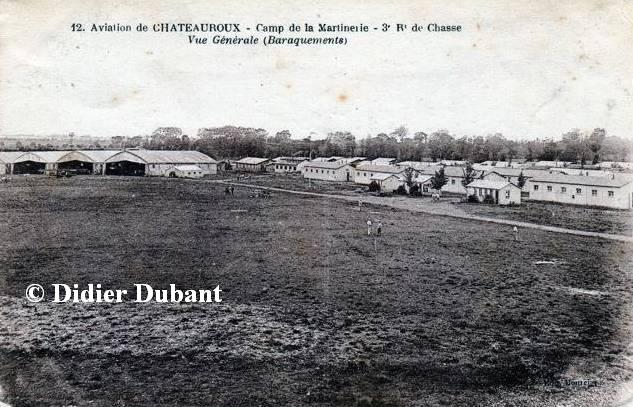 |
| Track, wooden barracks and hangars of the 3rd R.A.C. at Châteauroux La Martinerie (D.Dubant personal collection) |
| In its early stages, the 3rd R.A.C was composed of some eight hundred troops and officers, wooden barracks, and ten aircraft in three hangars. Engineers and pilots were split into two groups of three patrols using planes like Spad, Caudron, Nieuport 29 or 62, and Henriot 14. In 2008, two old French aviation hangars built during the late 1920s still existed in the south-western area of the base. Those two hangars, of metallic frame and structure, have on the upper part of their sides, large bay windows. Each hangar has a double pitched roof, linked by an inverted “V” shaped gutter perpendicular to their front, which are open toward the south-east, that is facing the airfield. |
|
|
| Metal frame hangars built in Châteauroux-La Martinerie in the late twenties Each shed has a double-sloped roof joined by an inverted V gutter perpendicular to its façade. (D.Dubant personal collection) |
|
The base surface gradually extended over the years, and in 1929 it finally crosses the departmental road D925 toward the north, enlarging the base of a dozen hectares all at once. In 2008, three former French aviation hangars still existed south of the road of Lignières. Still south of the road, but further east and aligned on a north-south axis, facing the airfield toward the west, four former French aviation double hangars remained in 2008. A few years later, in the context of the tripling of the offensive capability of the French Air Force, is decided in October 1936 the permutation between the 3rd R.A.C- which has become fighter wing - and the 32nd Dijon squadron. The 32nd squadron was made of two groups equipped of medium bombers : the groups I/32 and II/32. The II/32 left Dijon for Châteauroux on October 12, 1936, when it received Mureaux 115 single-engines on October 20, 1936. On October 15, 1936, it was the turn of the I/32, which left Dijon for Châteauroux with its Bloch 200 twin-engines. Both groups remained at the Martinerie until the beginning of the war. Then, on September 1, 1939, the I/32 group went back to Dijon, while the II/32 group left Châteauroux to join Chissey in the Jura. In 1940, the air base of Châteauroux-La Martinerie, a crossing point for numerous military units of the Air Force, is bombed several times by the German bomber aviation, then after the June 1940 defeat, became one of the Air Force Flights storage facility, the planes being henceforth grounded. After the 11th November 1942, the site is used by German fighter aircraft schools: the Jadfliegerschule 3 turned to Jadgeschwader 103, then the 2. JG 105. East of the Châteauroux-La Martinerie around the municipality of Diors, in the early 1944 the occupation authorities had built isolated cells to house light bombers. In 1944, the military base was bombed several times by Allied aircraft. On January 24, 1945, Châteauroux-La Martinerie became the first flying school that opened after the liberation of France. Then, after March 1946 the base is turned into a School of Transmissions and Storage, where various models of planes were stored before rejoining their military unit. When the French authorities handed the Châteauroux-Déols base over to the US authorities in 1951, 133 additional hectares are acquired, bringing its total surface area to 386 hectares. The early days of the US presence were epic. The 7029th Complement Squadron, assumed the role of the advance force to prepare the site for the arrival of the 73rd Air Depot Wing. Railway connection works began immediately, and large American aircraft landed on the ground still summarily outfitted. From July 4, 1951, the men were housed on the eastern side of the former airfield in Tent City: 240 ten-bed tents. In 1952, the American soldiers were progressively transferred to the rehabilitated barracks in the northern zone and at the beginning of October 1952 the first elements of prefabricated barracks arrived at the La Martinerie site to replace "Tent City". With a surface area twice that of "Quontown", with its metal prefabs, the first residents were welcomed in January 1953. The remains of two of these metal prefabs built on a concrete slab still remain in 2008. As one flies over the area, the concrete foundations of the western part of Quontown are still visible despite the thick bushes that now cover the area. At the end of December 1952, the completion of the paved runway at the Déols airfield obviates landings at La Martinerie. From then on, the site was strictly used for the storage of spare parts and war reserves intended for the Air Forces of NATO countries or not, concerned by the assistance measures for forces having acquired U.S. equipment (the countries concerned were France, Belgium, Italy, the Netherlands, Portugal, Denmark, Norway, Great Britain, Greece, Turkey, Yugoslavia and Iran). |
|
(photo Didier Dubant 2007 DR) |
|
Once the runway was completed at the Déols airfield, the construction companies switched to the erection of new buildings at La Martinerie. By July 1953, 1.200 workers were at work at La Martinerie: a hospital, a theater, a chapel, a mess hall, housing and administrative premises were under construction. Barracks and various functional buildings were then built to the north, then in the northwestern part of the site. The work was completed in May 1955, including the sewage system. South-east of the Base, in early 1953, a storage area of one million square feet (308,800 m2) on seventy-five hectares was built, including 93,000 m2 of covered warehouses. 1954 : Châteauroux Air Depot came under the command of the Air Materiel Force, Europe. 1956 : the American base of Châteauroux-Déols became the Central Air Material Area Europe (CAMAE). In july 1956, a golf course was officially opened on the site of the former landing zone of the Châteauroux-La Martinerie base. On September 5, 1956, the new CAMAE Commander "George F. SMITH" inaugurated trailer apartments at La Martinerie in the Quontown area. 1960, the base was transformed into : O.T.A.N. Supply Center of Châteauroux. On Thursday, March 23, 1967, a final ceremony marked the departure of the Americans from Châteauroux and Déols: "at 5:00 p.m., the time when every evening for the past fifteen years the American and French colors went down the flagpoles in the vast courtyard of La Martinerie, a brief ceremony marked the official closing of the U.S. Air Force base in the presence of hundreds of people, both military and civilian". On June 1, 1968, the liquidating echelon of the NATO supply center moved definitively to Luxembourg: "the flag of the Nato will no longer fly on building n° 356 of La Martinerie! In 1968, the military base of Châteauroux-La Martinerie partially returned to the French army: three Material Service Training Centers, number 2 in Lunéville and number 3 in Metz, followed in 1976 by number 1 in Montluçon, were regrouped there. In 1976, when the equipment became a full-fledged weapon, the CISM became the ESMAT (Ecole de Spécialisation du Matériel de l'Armée de Terre), a school that remained until the arrival of the 517th Train Regiment on July 3, 1998. |
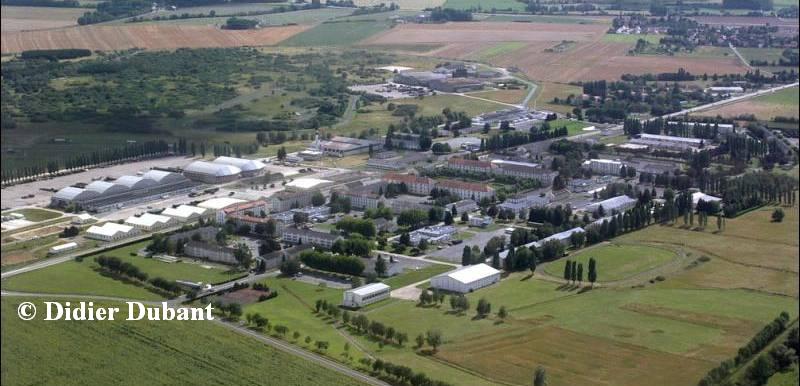 The Martinerie military base from the north-east. The Martinerie military base from the north-east. In the foreground the northern zone (in the center the red-roofed buildings frame the main courtyard). In the background in the center of the picture the airplane hangars of the western zone. (cliché Didier Dubant July 2007 DR). |
|
And for the other part of the Chamber of Commerce and Industry of Indre, which, at the request of the State, is in charge of the transformation of the storage center of La Martinerie into an industrial zone and of the marketing of this one. (NB: je n’ai pas tout à fait compris cette phrase alors la traduction n’est peut être pas adaptée) Deeply entrenched in the municipalities of Diors and Etrechet, the Martinerie industrial zone has been reusing a large part of the 93,000 m2 of warehouses of the former "NATO Supply Center" since June 1, 1968: "an 82,000 m2 shipping and storage area, a 13,000 m2 shipping and receiving area, including 2,000 m2 of covered space, 2,000 m2 of workshops, and 7,000 m2 of offices". |
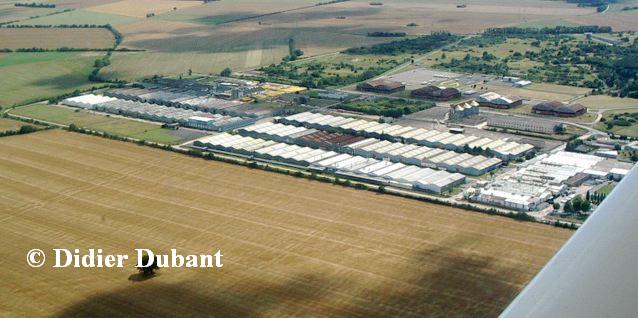 |
| The industrial zone of La Martinerie reuses since June 1st 1968 A large part of the 93.000 m2 of warehouses of the former "NATO Supply Center (photo Didier Dubant july 2007 DR). |
|
In the beginning of July 2012, the military zone of La Martinerie became, at the suggestion of the State, property of the Châteauroux Urban Community.
|
| Sources : Dubant D., Carrillon M., Mardelle S., Rollin N., Promenades dans Déols. Histoire des rues et lieux-dits d’une Commune de l’Indre. Office de Tourisme de Déols, 1998, 256 pages Dubant D., Déols et ses environs, Editions Alan Sutton, 1999,128 pages Dubant D., 50 ans d’aviation dans le ciel de l’Indre 1909-1959, Editions Alan Sutton, 2006, 160 pages Dubant D., Base américaine de Châteauroux-Déols 1951-1968, Editions Alan Sutton, 2008, 144 pages. |
|
|
|
|












